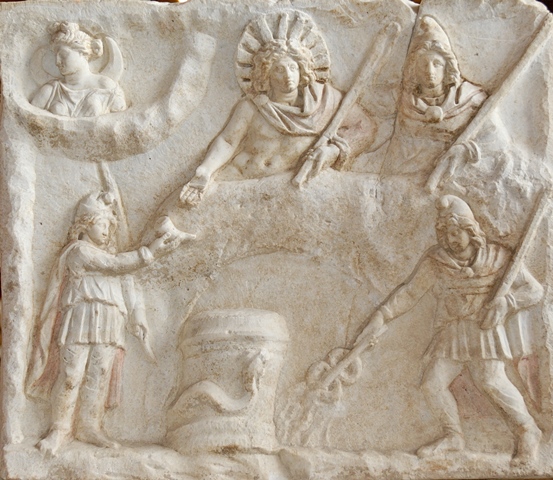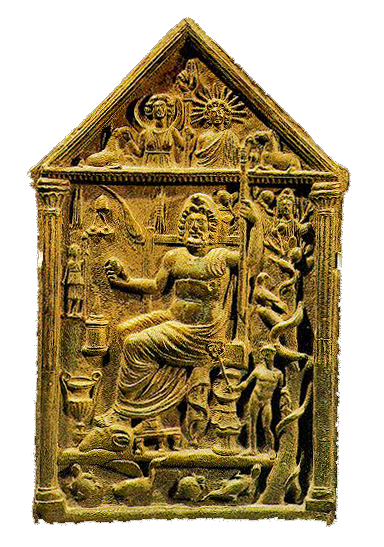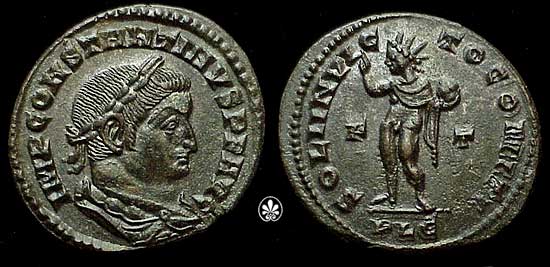The ancient Attic Greek festival known latterly as the ‘rural’ or ‘lesser’ Dionysia was celebrated – like Saturnalia and Christmas – just after the winter solstice in the second half of the Greek month of Poseidoneia which spanned December and January. The so-called ‘greater’ Dionysia festival, the Anthesteria, was a secondary development of the Greek city polities such as Athens and occurred a month or so later at the end of winter when the weather was finer. As befits its metropolitan status, it was a grander version of the rustic winter festival involving great public events, theatre, music and competitions as well as private celebrations of the Dionysian ‘mysteries’. None the less, it was otherwise effectively the same festival, its date transposed to enjoy better weather.
The ‘Rural Dionysia’ seems to have had many parallels with the Roman festival of Saturnalia which coincided with the roughly the same period, and which in the Christian era evolved into the ‘twelve days of Christmas’, culminating in the Feast of Epiphany – itself a festival almost certainly based upon the Dionysia, whose climax was the epiphany of the God Dionysus among the people. This brings us to an interesting confluence of deities: Poseidon (whose month it is), Saturn (Kronos, whose Roman name is based upon the Greek word for phallus: sâthe, as in satyr) and Dionysus.
The Dionysia – like the Saturnalia – was a time when classes came together in order to celebrate their shared origins in the natural world. Class distinctions were – to a degree – temporarily suspended and opportunities for public satire were made conducive by the wearing of masks and costumes by participants in the celebrations. It is believed that this festivity was the origin of the theatrical tradition for which Greece became so famous.
The god’s entourage at the Dionysia consisted of the male-gendered satyrs and the female maenads, although there was apparently a good deal of cross-dressing among the performers in some festivities. These accompanied the image of the god, which in its most rustic and ancient form was represented by a giant phallic pole of pine (a ‘xoanon’ image), coloured red and decorated, which was carried on a cart or on the shoulders of the phallophoroi. This made a ceremonial entry to the village or polis preceded by satyrs and maenads wearing animal skins (fawn and leopard, for example) wielding the thyrsus wand, and carrying cult objects such as jugs of wine, pithoi and krater vessels, plates of figs and a sacrificial goat.

The Dionysian ceremonial phallus and the ‘Phallophorai’ enters the polis. The act of the epiphanic procession had distinct sexual overtones.
The ithyphallic satyrs, sometimes darkened their faces with wine lees and engaging in ribald and ecstatic celebratory behaviour in honour of the god and the image of the phallus, which they wore a representation of apparently in the form of a codpiece with a leather erect penis attached to. Women (sometimes men) dressed as maenads or nymphs to complete the thiasos or retinue of the arriving god and took part in equally disinhibited behaviour and special ceremonies of their own. The maenads were a form of ‘bodyguard’ corps of the deity, and in mythology (and scandalous Roman reports) were sometimes portrayed as a maddened and frenzied bloodthirsty girl-mob who would rend and devour the flesh of men and animals. The ceremonial rending of the sacrificial goat, and even the eating of its raw flesh may be behind this opinion.
Special songs (dithyrambs) were composed and sung and, naturally, wine was drunk and sacrifices offered to Dionysus, the god of sprouting vegetation and urgent returning nature. Group-experiences, comedy, humour and jollity were the order of the day and inhibitions were temporarily cast aside.
Origins of the Christmas Tree: The Pine and the Phallus:
The display of the phallus was an important symbolic aspect of the rites of the Dionysia, as well as being prominent in the equivalent Roman festival of Liberalia (held in March near to the spring equinox). Records (including the drinking vessel pictured above) speak of the giant decorated totemic phallic pole (made of the hewn erect trunk of an evergreen pine tree) which was paraded with the ‘coming’ of the god, accompanied by men dressed as satyrs with erect phalli attached to their costumes. A pole bearing the same image (carved from fig wood) was also sported by celebrants in the thiasos. The thyrsus wand depicted as carried by Dionysus as his symbolic weapon and badge of office was also brandished by the maenads and was itself also a depiction of the phallus: it was typically made of a pine cone mounted upon a staff, sometimes wreathed with ivy.
The pine tree was (like the vine and the fig) a totem plant of Dionysus. It evokes a similitude with the androgynous castrated Phrygian god Attis, who was likewise strongly associated in myth with the pine tree. Attis was consort of the great mother goddess Cybele, identified with Kronos’ wife Rhea in Greek mythology. Kronos, of course, castrated his father Ouranos. The pine is both evergreen and erect in habitus so is a fine metaphor for the phallus – its sticky sap a metaphor for semen.
It appears that Dionysus was actually a god of the ‘sap’, ‘spirit’ or ‘essence’ stimulating life. Maximus of Tyre (perhaps commenting on the phallic totem pictured above) wrote in the 2ndC CE that:
“…the peasants honour Dionysos by planting in the field an uncultivated tree-trunk, a rustic statue…”
Plutarch observed the contemporary belief that the god was a god of moisture – associated with life and vigour. One of the epithets of Dionysus was Dendrites – ‘of the trees’ – an indicator of his connection to branching life, and a metaphor of the familial tree of humanity. The tree was similarly a metaphor for rivers whose branching nature was morphologically similar. This links Dionysus to Poseidon who was god of waters – Okeanos (i.e. – the sea) being conceived of as a confluence of the world’s rivers.
Furthermore, the pine was a tree of the hot mountainside characterising the uplands of southern Europe, the Near and Middle East and North Africa. These wild places were a typical mythological resort of Dionysus and his retinue. The god’s birthplace was said to have been on a mountainside on the mythical Mount Nysa, nurtured by nymphs – the Hyades – whose stars form a cluster on the crown of the constellation of Taurus – the Starry Bull, representative of Asia and Europe’s wild Aurochs from which many of the world’s domestic cattle breeds are derived…
The mythical origins of mankind are often expressed in European folklore in the form of an ascent from oneness with the animal world. From the fables of Aesop (6thC BCE?) and further still into antiquity we see a tendency to illustrate the identity of humans with animals, just as in ancient Egyptian and Greek religion, the gods had a similar identity with the animal kingdom. Mythologically, the oneness occurs at the vanishing point characterised as the oldest period in a time without memory – a point firmly identifiable in ancient Greek mythology with Kronos, the Titans and Gigantes, and the ‘Golden Age’. This was an age when human heroes battled monsters in far-off realms and had no fixed era by historical reckoning, yet was typically used as a starting point in the reckoning of histories from the Classical period onwards.
This is the ancient, primal and even bestial ‘vanishing point’ which Dionysus (and humanity itself) appears to emerge from and to which the god mystically returns in his annual cycles of travel among humanity. Kronos (Saturn) and even Hades may represent his more distant self – forever marooned on the far shores of time at the limits of the great world-river Okeanos, or beyond in the shady realms of Elysium and Tartaros. These were all once believed to be linked by the earth’s waters. Indeed, this aquatic existence summons to us the identity of the third god in this apparent ancient triad: Poseidon, in whose lunar month the Greeks celebrated their oldest Dionysia.
Poseidon was the brother of Zeus and Hades, and together they formed a triumvirate who represented the dominion of the sea, the sky and the underworld respectively. Hades was celebrated as an important divine figure in the mystery religions, in particular the Eleusinian Mysteries – as the abductor and husband of Persephone (Kore), daughter of the goddess of the fruitful earth – Demeter. The seasonal drama of nature was said to depend on her annual passage into the underworld in the depths of winter when fruitfulness and vegetation dies back.
A curious identity exists between the gods Dionysus and Hades, hinted at by the ancient ‘Homeric Hymn to Demeter’ – a versified account of the Eleusinian myth. This states that Persephone was abducted in the ‘fields of Nysus’, from which Dionysus appears to get his name (‘God of Nysus’). Dionysus was said in other legends to have been raised on a place called Mount Nysus by the nymphs known as the Hyades, daughters of the Titan Atlas whose stars form the crown on the ‘Starry Bull’ constellation, Taurus. Pre-Socratic Greek philosopher Heraclitus (5thC BCE) also stated that Hades and Dionysus were the same – a unification of opposites: One the god of indestructible quintessence of life and the other the lord of irresistible death, from which new life mystically arises through the fertilising processes of putrefaction. It is likely this was a key secret in the mysteries of Eleusis, and is part of a similar death<>life narrative encountered again in the story of Apollo slaying Python, and Perseus slaying Medusa. All such encounters occur in the murky Stygian regions – often characterised as lying in a misty place at the far reaches of Poseidon’s realm, characterised over all by the concept of the unifying waters – Okeanos.
The mysteries of life and death link in the cult of Dionysus, and remembered in the Roman Saturnalia: Both were eventually continued in the cult of Jesus Christ and ‘Christmas’. The traditions of dressing up as beast-men, collecting together to sing songs and enjoy the communal fantasy of theatre and dramatic entertainment, as well as the public expression of satire and comedy still mark Europe’s Christmas and Epiphany festivals. The Christmas Tree also has its origins in the Dionysia.





